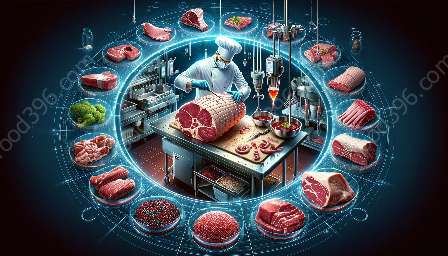Meat processing is a complex and intricate industry, involving various stages from slaughtering to packaging. Throughout this process, the presence of microbial hazards poses a significant threat to the safety and hygiene of meat products. Understanding these hazards, along with their implications and preventive measures, is crucial to ensuring the production of safe and wholesome meat products.
Microorganisms in Meat Processing
Microbial hazards in meat processing encompass a wide range of microorganisms, including bacteria, viruses, parasites, and fungi. These microorganisms can contaminate meat at different stages of processing, leading to foodborne illnesses and economic losses.
Bacterial Hazards
Bacteria are among the most common microbial hazards in meat processing. Pathogenic bacteria such as Salmonella, Escherichia coli, and Listeria monocytogenes can cause severe foodborne illnesses when present in meat products. These bacteria can enter the meat supply chain during slaughter, processing, or through cross-contamination.
Viral Hazards
Viruses such as Hepatitis E virus and norovirus can also pose a risk in meat processing. These viruses can be transmitted through contaminated water, food, or contact with infected animals, highlighting the need for stringent hygiene and sanitation measures in processing facilities.
Parasitic Hazards
Parasites like Trichinella and Toxoplasma gondii may contaminate meat, particularly in pork and game meats. Proper cooking and freezing methods are essential to eliminate parasitic hazards in meat products.
Fungal Hazards
Fungi, including molds and yeasts, can cause spoilage and mycotoxin contamination in meat products. Proper storage and humidity control are critical in preventing fungal growth and safeguarding meat quality.
Meat Safety and Hygiene Considerations
Ensuring meat safety and hygiene in the face of microbial hazards requires a comprehensive approach that integrates good manufacturing practices (GMP), sanitation, and quality control measures. Key considerations include:
- Sanitation Protocols: Implementing robust cleaning and sanitation protocols throughout the processing facility to minimize microbial contamination.
- Temperature Control: Maintaining proper temperature control from slaughter to processing and storage to prevent microbial growth and spoilage.
- Hygienic Handling Practices: Training and educating personnel on hygienic handling practices to prevent cross-contamination and minimize microbial risks.
- Pathogen Detection: Utilizing techniques such as microbiological testing and molecular methods to detect and monitor pathogenic microorganisms in meat products.
- Regulatory Compliance: Adhering to stringent regulatory standards and guidelines set forth by food safety authorities to ensure meat safety and hygiene.
Meat Science and Microbial Risk Assessment
Meat science plays a pivotal role in understanding and mitigating microbial hazards in meat processing. Through the application of scientific principles and technologies, it is possible to assess, mitigate, and manage microbial risks effectively.
Microbial Risk Assessment
Microbial risk assessment involves the systematic evaluation of microbial hazards, exposure pathways, and the potential impact on public health. This process enables meat processors to quantify and manage risks, leading to the implementation of targeted control measures.
Predictive Modeling
Advances in meat science have facilitated the development of predictive microbiology models that assess the growth and behavior of microbial hazards in meat products under varying environmental conditions. These models aid in designing preventive strategies and optimizing processing parameters for enhanced safety.
Intervention Strategies
Meat science research has contributed to the development of intervention strategies to control microbial hazards, including the use of antimicrobial agents, hurdles technology, and innovative processing techniques. These interventions aim to reduce or eliminate microbial contamination while preserving the sensory and nutritional attributes of meat.
Conclusion
Microbial hazards in meat processing present formidable challenges to meat safety and hygiene. However, by integrating knowledge from meat science, adhering to strict hygiene practices, and employing risk-based approaches, the industry can effectively mitigate these hazards and ensure the production of safe and wholesome meat products.

